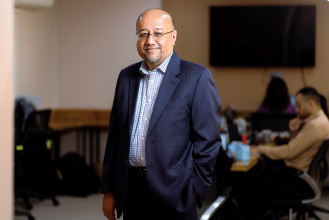
While one might argue that the tech sphere in Nepal is still rather infantile in contrast to its Silicon Valley counterparts, the past few years have pushed the nation to grow more and more digital. Technologies and services that one would only perceive in Hollywood flicks have slowly but steadily started to become an accepted part of urban Nepali life. Today tech has begun to encompass every possible aspect of our lives and has been changing the way we interact with our community. Atulya Pandey happens to be one of the trailblazers who is at the helm of elevating Nepali tech to new heights. I first met Pandey two-and-a-half years ago. Back then it was to talk about Pagevamp, a company that he and a couple of his friends started during their undergrad years from their dorm at the University of Pennsylvania. However, during our conversation then, Pandey had also mentioned a new company called Outside that he had just co-founded with his partners Sujan Shrestha and Vincent Sanchez-Gomez. At the time, Pandey referred to it as Outside.Tech, which sought simply to solve their client’s tech needs. However, with changing times also came changed ambitions; since then Pandey and his team dropped the ‘Tech’ and have managed to exponentially grow Outside to not just be a tech company but a venture that truly embodies the Nepali entrepreneurial spirit.
Going OUTSIDE Now Pandey introduces Outside as an impact driven design and technology studio based in Kathmandu. And what does this mean, exactly? In Pandey’s own words, “We do a lot of creative design, branding, software development, and enterprise website development for clients that share our values and vision for a better future. In other words, a lot of our clients come to us with their own mission and goals and we try to bring it to life through design and technology.” Currently, Pandey and Outside have amassed an impressive portfolio of projects that ranges from domestic SMEs all the way to international legacy entities. A few familiar names might include Inside Himalayas, The New Yorker, Rockefeller Foundation, and the Statue of Liberty & Ellis Island Foundation. However, much like any innovative venture, Outside did not start shining from day one. In fact, it started when Pandey decided to make a gutsy choice to move back to Nepal from New York where Pagevamp was then based. This was in 2015, and at the time, Pandey and his team sought to focus on Asia expansion by building a team in Kathmandu. But for better or worse, things do not always work out the way that we usually want them to. Pandey shares, “Pagevamp had its ups and downs. By 2019, its growth had slowed down. Pagevamp had always been a little more investor dependent, and we wanted to remove our dependency on investment.” This is when Pandey began to weigh in on the positives of the cards he had on hand. He understood that over the years they had managed to build a solid team, developed an expansive global network, and had a wanting to do something different. Thus began the first inklings of Outside as an entity. Pandey and the team decided that they wanted to shift from a product-based investment-heavy business like Pagevamp and instead move into a service-based model and start providing design and web-software solutions to clients. During this transition, Pandey also realised that for Outside to be a company he could feel passionate about building, it could not function as your everyday outsourcing company. It needed to have a larger, more meaningful purpose. “We didn’t want to create an outsourcing company or an off-shore hub. We were excited about working with businesses that had a social mission, where we could help them amplify their impact through our technology and design.”  Putting money where your mouth is An intriguing question one might have for Pandey and his co-founders is why would anyone pluck a growing enterprise from the bustling New York City markets, only to base it primarily in quaint Kathmandu? Certainly, one would have access to more clients and investor pools when they are based in a city like New York? Well, Pandey boldly answers this query, stating that a big part of the Outside identity has to do with their hometown of Kathmandu. “We very much stress on Kathmandu. We are a Kathmandu-based studio and this is a stigma that we have constantly been fighting,” shares Pandey. He explains, “Sure we can still say that we are a New York-based agency, after all that’s where my co-CEO is. We could even say we are a London-based agency, we have our creative director there. And this has been what a lot of people have advised us to do because when you’re talking about a global agency these are the core hubs. But we wanted to fight that notion and we wanted to put Kathmandu front and centre. We wanted people to see that really awesome things can come out of Kathmandu.” Pandey does note that this change of perception cannot happen by simply basing companies in Kathmandu, it is also equally important to actively invest in developing and growing the communities here. “If the whole technology community here comes together, then we grow, but also Kathmandu’s brand name as a tech hub is bolstered.” Outside itself has gone the extra mile to bring more elements of Kathmandu into their brand, be it through changing logos and colour palettes or by unabashedly embracing their Kathmandu roots. And over time, this has actually seemed to work in favour of Outside. Pandey admits, “We have realised that a lot of our global clientele actually have a positive affinity towards Nepal. Even when we send out cold emails, people are excited to find out that we are from Nepal.” What is even more important is an intentional focus that encompasses the community all the while getting things done. Outside, in particular, has supported a working model based around three core pillars: a start-up studio, an agency, and community impact. First of the three, and perhaps the most straightforward pillar happens to be the start-up studio. Here, Pandey explains that they have managed to integrate existing products like Pagevamp with other possible in-house products. The agency side, on the other hand, appears to function as the service arm for Outside. Through this, anybody or any business can reach out to the company with their own sets of challenges and needs. And finally, their community impact efforts focus on making the Nepali tech and entrepreneurial community more inclusive, equitable, supportive, and productive. While the start-up studio and agency allow for a steady income source for Outside, the latter pillar works to bring together a scattered tech community in Nepal while also creating an atmosphere of collaboration and advancement. Examples like Outside’s design workshops and their DevOps community are all institutional efforts to uplift - not just their own - but the whole Nepali tech community through a process of knowledge sharing. While Outside is determined to do a lot for the sake of the wider Nepali tech community, investing in the community also includes investing in the company’s own people. Pandey shares an interesting occurrence that came about within Outside, “The guys at the company happened to play futsal after-hours to socialise and have some fun. We had invited the women in our company to join in too, but a lot of them were not particularly enthused by the idea.” After several conversations on the topic, it emerged that a key reason behind the women being disinterested in futsal stemmed from them being shunned away from sports as kids, thus never having had a chance to enjoy futsal and become skilled in the way the men had. “Given this context, it’s totally understandable that they would be hesitant to participate,” tells Pandey. That said, the decision to not participate was not rooted in an actual disliking of sports, but rather a lack of support and experience. Pandey explains, “We collaborated with an organisation called We United that goes around Nepal and trains female football coaches. They invited the women on our team to go through a four-day boot camp with their coaches. Not only did this introduce them to the sport, but they told us that the training programme helped with their personal and professional confidence levels as well.” Pandey goes on to state that while something like this might be seen as a minor thing, it subtly encourages employee confidence, networking, and increased productivity in the workplace – which can be important factors in narrowing a significant gender gap in Nepal’s tech industry.
Putting money where your mouth is An intriguing question one might have for Pandey and his co-founders is why would anyone pluck a growing enterprise from the bustling New York City markets, only to base it primarily in quaint Kathmandu? Certainly, one would have access to more clients and investor pools when they are based in a city like New York? Well, Pandey boldly answers this query, stating that a big part of the Outside identity has to do with their hometown of Kathmandu. “We very much stress on Kathmandu. We are a Kathmandu-based studio and this is a stigma that we have constantly been fighting,” shares Pandey. He explains, “Sure we can still say that we are a New York-based agency, after all that’s where my co-CEO is. We could even say we are a London-based agency, we have our creative director there. And this has been what a lot of people have advised us to do because when you’re talking about a global agency these are the core hubs. But we wanted to fight that notion and we wanted to put Kathmandu front and centre. We wanted people to see that really awesome things can come out of Kathmandu.” Pandey does note that this change of perception cannot happen by simply basing companies in Kathmandu, it is also equally important to actively invest in developing and growing the communities here. “If the whole technology community here comes together, then we grow, but also Kathmandu’s brand name as a tech hub is bolstered.” Outside itself has gone the extra mile to bring more elements of Kathmandu into their brand, be it through changing logos and colour palettes or by unabashedly embracing their Kathmandu roots. And over time, this has actually seemed to work in favour of Outside. Pandey admits, “We have realised that a lot of our global clientele actually have a positive affinity towards Nepal. Even when we send out cold emails, people are excited to find out that we are from Nepal.” What is even more important is an intentional focus that encompasses the community all the while getting things done. Outside, in particular, has supported a working model based around three core pillars: a start-up studio, an agency, and community impact. First of the three, and perhaps the most straightforward pillar happens to be the start-up studio. Here, Pandey explains that they have managed to integrate existing products like Pagevamp with other possible in-house products. The agency side, on the other hand, appears to function as the service arm for Outside. Through this, anybody or any business can reach out to the company with their own sets of challenges and needs. And finally, their community impact efforts focus on making the Nepali tech and entrepreneurial community more inclusive, equitable, supportive, and productive. While the start-up studio and agency allow for a steady income source for Outside, the latter pillar works to bring together a scattered tech community in Nepal while also creating an atmosphere of collaboration and advancement. Examples like Outside’s design workshops and their DevOps community are all institutional efforts to uplift - not just their own - but the whole Nepali tech community through a process of knowledge sharing. While Outside is determined to do a lot for the sake of the wider Nepali tech community, investing in the community also includes investing in the company’s own people. Pandey shares an interesting occurrence that came about within Outside, “The guys at the company happened to play futsal after-hours to socialise and have some fun. We had invited the women in our company to join in too, but a lot of them were not particularly enthused by the idea.” After several conversations on the topic, it emerged that a key reason behind the women being disinterested in futsal stemmed from them being shunned away from sports as kids, thus never having had a chance to enjoy futsal and become skilled in the way the men had. “Given this context, it’s totally understandable that they would be hesitant to participate,” tells Pandey. That said, the decision to not participate was not rooted in an actual disliking of sports, but rather a lack of support and experience. Pandey explains, “We collaborated with an organisation called We United that goes around Nepal and trains female football coaches. They invited the women on our team to go through a four-day boot camp with their coaches. Not only did this introduce them to the sport, but they told us that the training programme helped with their personal and professional confidence levels as well.” Pandey goes on to state that while something like this might be seen as a minor thing, it subtly encourages employee confidence, networking, and increased productivity in the workplace – which can be important factors in narrowing a significant gender gap in Nepal’s tech industry.
Tech in Nepal When asked how he would define the IT space in Nepal, Pandey says, “It is the highest potential industry with ridiculous demand, but I don’t think we have the supply of talent to meet this demand.” According to him, the IT industry is one where the physical limitations of national geography and political borders hardly matter. “You could come up with a webpage design in Kathmandu and easily email it to a client at the other end of the world,” elucidates Pandey, adding, “Unlike other industries, we don’t need to worry about costly logistics, just a bit of good wi-fi will do.” Unfortunately, something that Pandey does note is that oftentimes when we talk about the tech scene in Nepal, we are simply referring to a few metropolitan hubs in the country. “Ideally anybody anywhere could remotely be a part of the tech industry. Sadly, in our case there are certain economic, educational and infrastructural barriers to this,” says Pandey who firmly believes that tech companies in Nepal need to work towards minimising the barrier of entry to the tech sphere in places outside of the handful of metropolitan hubs in Nepal. In terms of how Nepali tech would fare against its foreign counterparts, Pandey believes that the top talent in Nepal’s tech space are not lacking in innovation or technical skill, rather an area of concern that has handicapped the industry is that there is such a low volume of this talent to meet the demand, in addition to a general industry-wide lack of emphasis on user experiences. “We are part of a talent-based industry. And despite being rather condensed, the talent here is certainly capable of delivering globally competitive products. Even so, the problem here is that with such a small talent pool, the entire tech sphere is forced to try and one-up each other to hire the same people,” he explains, adding, “As for the products that we put out, where we are underperforming relative to global competition is in regards to the quality of our user experiences. You are able to communicate your product more effectively if your design is better, and in Nepal, I think a lot of companies tend to under-invest in this area.” Pandey further goes on to explain that tech for tech’s sake is not inherently valuable. While he believes that tech innovations that have been raised and nurtured in Nepal are just as good as any international competition, he also says, “Simply deploying a tech product to an international market is relatively easy. The bigger challenge is being able to understand the unique qualities of different markets and adjusting your products accordingly, which requires a nuanced understanding of people and culture, not only tech. Ultimately we are addressing human needs, and those needs may feel intuitive for our local environment, but we cannot copy and paste our services across the world and expect them to be equally valuable.”  So how can these problems stalling Nepali tech be solved? Well, Pandey seems to have a few opinions, the first one focusing on education. He states, “We want to be more proactive when it comes to working with educational institutions. Oftentimes we find that graduates don’t have a strong foundation when it comes to writing actual code and building tech. With tech evolving at such a rapid rate, it seems that the curriculums here aren’t able to keep up. I’d even say that a majority of computer science graduates here usually end up starting from scratch in their first job.” As for the government and policy making end of things, Pandey admits that he does not hold a lot of high expectations with so much political instability in Nepal. He says, “There are a lot of policy-level investments that need to happen to take Nepali tech forward. But for us solely getting our work done, the most we’d ask for is good internet and regular electricity.” Apart from these things, Pandey also believes people still tend to undervalue the cost of labour required to create a quality digital product. “We need to make people understand that our work is not just a matter of copy-pasting a single line of code, but rather a process that requires a significant amount of time, energy, and skill.” What Pandey does not want the Nepali tech industry to develop is a reputation for cheap labour. And while a low salary in NYC would certainly pass as a good wage in Kathmandu, Pandey holds the notion that it is not something that we as a nation should be striving towards. He explains, “When you start fighting for cheap labour, then there will always be labour that’s cheaper than what you are offering, and thus begins a race to the bottom that fosters exploitation.” Instead, Pandey wants Nepali tech to be able to hold their value and work to deliver the quality of that value such that a comfortable life can be maintained by those employed in the industry, instead of always undercutting costs and compromising quality as a result.
So how can these problems stalling Nepali tech be solved? Well, Pandey seems to have a few opinions, the first one focusing on education. He states, “We want to be more proactive when it comes to working with educational institutions. Oftentimes we find that graduates don’t have a strong foundation when it comes to writing actual code and building tech. With tech evolving at such a rapid rate, it seems that the curriculums here aren’t able to keep up. I’d even say that a majority of computer science graduates here usually end up starting from scratch in their first job.” As for the government and policy making end of things, Pandey admits that he does not hold a lot of high expectations with so much political instability in Nepal. He says, “There are a lot of policy-level investments that need to happen to take Nepali tech forward. But for us solely getting our work done, the most we’d ask for is good internet and regular electricity.” Apart from these things, Pandey also believes people still tend to undervalue the cost of labour required to create a quality digital product. “We need to make people understand that our work is not just a matter of copy-pasting a single line of code, but rather a process that requires a significant amount of time, energy, and skill.” What Pandey does not want the Nepali tech industry to develop is a reputation for cheap labour. And while a low salary in NYC would certainly pass as a good wage in Kathmandu, Pandey holds the notion that it is not something that we as a nation should be striving towards. He explains, “When you start fighting for cheap labour, then there will always be labour that’s cheaper than what you are offering, and thus begins a race to the bottom that fosters exploitation.” Instead, Pandey wants Nepali tech to be able to hold their value and work to deliver the quality of that value such that a comfortable life can be maintained by those employed in the industry, instead of always undercutting costs and compromising quality as a result.
What next The Nepali tech industry has certainly grown and continues to grow at an exponential rate. Pandey and Outside’s journey is a testament to that. As a matter of fact, Pandey shares that despite all the adversities that enterprises have had to face over the course of a global pandemic, Nepali tech companies have managed to stay relatively unscathed. Outside even managed to more than double the size of its team over the last year. And this is simply because of the intangible nature of tech innovations and how people are gradually warming up to these changes. “Businesses have begun to realise that while a shop might be able to sell products for 7-8 hours a day, a website can do that 24/7. And customers also have grown to become more adoptive of digital services and technologies,” believes Pandey. “We are living in an exciting time for tech but we have to collectively figure out where we want to go as an industry,” Pandey adds. He goes on to emphasise that we need to actively begin to expand the talent pool that we have available in the country and give more Nepalis the exposure to be able to dream bigger. Pandey concludes by saying, “We are in a situation where we have the ability to determine what sort of tech industry we want to create. We can build a more inclusive industry from the ground up. And we certainly don’t have to follow the likes of places like Silicon Valley. What we should strive for is to create an industry that focuses on innovation, building tech that has a positive impact and with no compromise on the physical and mental wellbeing of the people working on it.”





-1757917838.jpg)